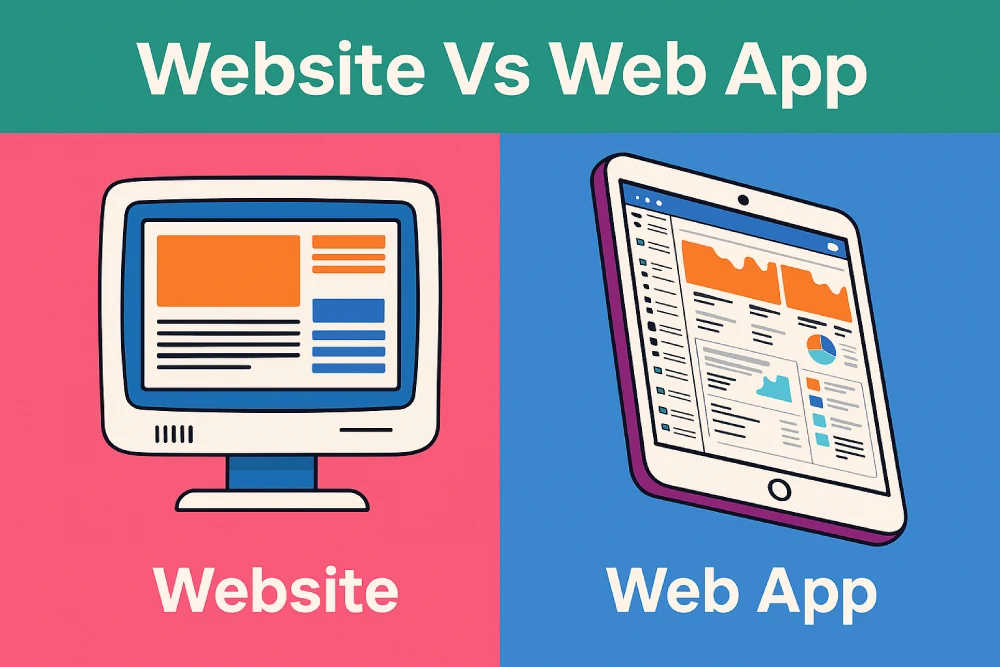Table of Contents
In today’s rapidly evolving digital world, businesses face an important decision when establishing their online presence: choosing between a website and a web application. While these terms are often used interchangeably, they represent different digital solutions, each with its own strengths and purposes. We’ve observed that understanding these differences is crucial for businesses to make informed decisions about their digital strategy.
As the digital world continues to evolve, the line between websites and web applications sometimes blurs, but their core differences remain significant. This comprehensive guide will help you understand the key distinctions, enabling you to make the right choice for your business needs and goals
Understanding the Basics
Websites are primarily informational platforms that present static content to visitors. Think of them as digital brochures that showcase your products, services, and company information. According to recent statistics from Web Technology Surveys, traditional websites still make up approximately 75% of all web properties globally.
Web applications, on the other hand, are interactive software programs that run on web browsers. They’re designed to perform specific functions and often require user input to deliver personalized experiences. Research by Statista shows that the web application market is growing at an annual rate of 16.9%, highlighting the increasing demand for interactive web solutions.
| Feature | Web Application | Website |
|---|---|---|
| Purpose | Designed for user interaction | Primarily displays static content |
| User Interaction | Users can read and modify data | Users can only read content |
| Complexity | More complex functionality | Simpler functionality |
| Compilation | Needs to be precompiled before deployment | No need for precompilation |
| Interactivity | Highly interactive for users | Mostly non-interactive |
| Browser Requirements | Requires advanced browser capabilities | Works with basic browser features |
| Integration | Complex due to advanced features | Easier integration |
| Authentication | Usually requires login/authentication | Authentication is rarely needed |
| Examples | Amazon, Facebook, Gmail | News websites, university websites |
Key Differences in Functionality
User Interaction Level
Websites typically offer one-way communication, where users consume content without significant interaction. For example, a restaurant’s website might display its menu, location, and contact information.
Web applications enable two-way communication and complex interactions. Consider a food delivery platform where users can place orders, track deliveries, and manage their profiles – all features that Orange Panda, as a website development agency, frequently implements for clients.
Data Handling
Traditional websites primarily store and display static content, requiring manual updates from administrators. According to industry data, the average website updates its content once every 23 days.
Web applications process real-time data and often integrate with databases and external services. They can handle thousands of simultaneous user interactions and update information instantly.
User Interaction and Experience
Navigation Patterns
Websites follow predictable navigation patterns, with users moving through pre-defined paths to access information. The average user spends 2-3 minutes on a standard website.
Web applications offer personalized experiences based on user behavior and preferences. Users typically engage with web applications for longer periods, with average session times of 7-8 minutes according to recent UX studies.
Responsiveness
Modern websites built by experienced agencies like Orange Panda ensure responsive design across devices. However, their functionality remains relatively constant regardless of screen size.
Web applications adapt not just their appearance but also their functionality based on the user’s device and context, providing a more tailored experience.
Development and Maintenance
The development process for websites typically takes 4-8 weeks and requires less complex programming. Basic websites can be built using standard HTML, CSS, and minimal JavaScript.
Web applications demand more sophisticated development approaches, often taking 3-6 months to complete. They require extensive backend programming, database management, and regular updates to maintain security and functionality.
Cost and Resource Implications
Initial Investment
- Website development: ₹40,000 – ₹5,00,000*
- Web application development: ₹5,00,000 – ₹25,00,000 and above*
*Cost depends on various factor such as: features, level of detailing, research , complexity of project etc.
These figures from recent market analysis in Ahmedabad show the significant difference in initial investment required for each option.
Maintenance Costs
Websites typically require minimal maintenance, with annual costs ranging from 10-20% of the initial development cost. Web applications need regular updates and monitoring, with maintenance costs often reaching 25-40% of the initial investment annually.
Making the Right Choice for Your Business
Consider your business objectives, budget, and user needs when choosing between a website and web application. For businesses like Rajesh’s spice company, transitioning from a website to a web application made sense due to growing customer demands for interactive features.
Conclusion
Understanding the distinction between websites and web applications is crucial for making informed digital decisions. While websites excel at presenting information, web applications offer dynamic functionality that can transform how businesses operate online.
Ready to determine which solution best fits your business needs? Contact Orange Panda, your trusted digital marketing agency in Ahmedabad, for expert guidance and implementation. Schedule a consultation today to explore how we can help you achieve your digital goals.


